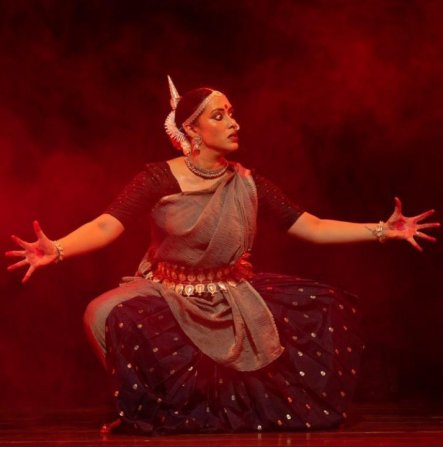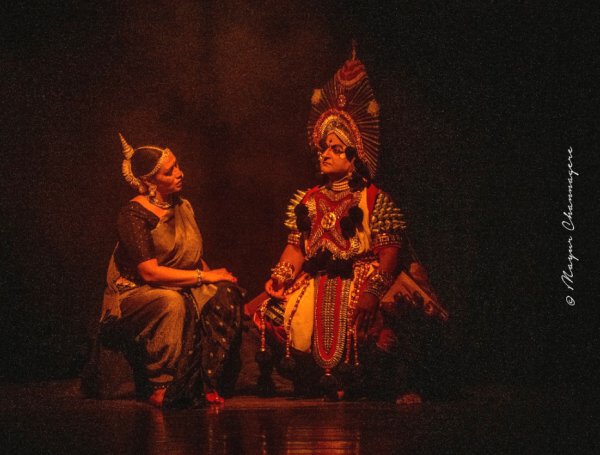
|   |

|   |
Shurpanakhi: A rare feminine facet - Jyothi Raghuram e-mail: jyothi.r.ram@gmail.com June 8, 2022 Shurpanakhi, a central character in the Valmiki Ramayana, and the catalyst through whom the epic unfolds, is at once detestable and comic, as brought to us through stage dramatizations. Papers galore have been presented against the "patriarchal values" of Valmiki, the feminist points of view giving one-dimensional, gender-biased colours to a female character that led to the unravelling of the Ramayana. Literary freedom allowing for such interpretations of characters and the epic itself have in fact led to the writing of hundreds of versions of the original Valmiki Ramayana.  Vandana Supriya Photo: Jayasimha Reddy Be that as it may, perhaps a clear stance becomes necessary for effectively establishing a theory in stage adaptations revolving around such a "shamed" character. Here was one such dance presentation that moved beyond the cliched, did not speak as an activist or feminist voice, but put forth the feminine aspect of Shurpanakhi in a thoughtful manner, without much ado. It revealed the emotional and physical pain of a mutilated Shurpanakhi, consequent to falling in love with a handsome man, and making bold to propose to him. It was this tragedy that was effectively communicated, rather than pointing to a patriarchal humiliation of Shurpanakhi or hammering on sexist stereotyping. Credit for presenting Shurpanakhi as just another woman who was in love, but was wronged, goes to Vandana Supriya Kasaravalli, whose Shurpanakhi: The woman inside the demon, offered a heart rending, different perspective. A mix of theatre and dance via Yakshagana and Odissi, Shurpanakhi had robust humour to take the story forward, excellent exchange of dialogues that were humanizing and progressive, and dance elements that added to the drama and movement. Conceptualised and directed by Vandana, Shurpanakhi began on an intriguing and dramatic note with the entry of the main character, a role donned by Vandana with aplomb. The drama surrounding this entry was yet fine, difficult to achieve in an ultra feminine form such as Odissi, given the apparently masculine proportions and gait of Shurpanakhi. Vandana's countenance was at once hefty and graceful! Here, the typical chowka and tribhangi were used effectively. Humour, gently introduced through her demeanour and facials, found way in the dialogues too. That there was nothing grotesque attached to the persona of Shurpanakhi was in itself a defining factor of the production. Yakshagana artiste Krishnamurthy Thunga as the sutradhara, communicated with gusto, the inflections of his dialogue delivery and sense of comic timing being his bestselling points.The informal, brisk dialogues, with generous doses of humour, did not take away from the dramatics.  Vandana and Krishnamurthy Thunga Photo: Mayur Chennagere The erotica of Shurpanakhi was classy; Raghava narapathe shrunu mama vachanam, the refrain to woo Rama, shown symbolically through a bow and arrow, was impactful visually and emotionally. In the midst of this wooing as a lovelorn damsel, traces of her being Shurpanakhi came to the fore, establishing the character's other facets. What one recalls most, both with a sense of admiration at the portrayal, and the tragic turn of Shurpanakhi's love, is her distress as to whether Rama will accept her as people of Lanka are considered as rakshasas. Fear writ large on her face, she looks into her reflection in the pond. Laughing, she says to herself that this is no Shurpanakhi. The crassness turns into grace as if by magic. The traits of Shurpanakhi don't stay dormant, resurfacing ever so artfully, vouching for Vandana's transforming abilities! Even as Shurpanakhi sobs at her bloody state just for begging for Lakshmana's love, her disfigured face makes her take a philosophical turn as a shaanthamurthy - a new, insightful dimension given to Shurpanakhi's character. Vandana's expressions left little room for imagination, as, for instance, in her descriptions of Rama and Lakshmana.The easy flowing, cogent script of Apurva Kasaravalli was central to the communication of Shurpanakhi, with a wit and philosophy all its own. Thunga's lively stage presence was certainly a plus, holding centre stage with the protagonist. But the special smoke effects that ran through the entire show, was a case of overkill, the haze literally clouding the stage, at times taking away from the sharpness of the dancers' expressions too. The carefully chosen lyrics, from varied sources-Vyasrao Ballal, Karthik Hebbar, Medhini Hegde, and Parthisubba (a 17th century composer well known for his composition of Yakshagana prasangas), were well knit, Hemant Kumar's music direction making a musical statement of every lyric. The finishing moments of Shurpanakhi, to the singing of Kadu mallige ondu kaadinalli naraluthidhe, made for a poignant ending where Shurpanakhi compares herself to a jasmine born in the forest, and destined to wilt there. The allegory was not lost, summing up all that was feminine in Shurpanakhi, with a pathos that was heart wrenching. However, the production was a trifle lopsided as the dance element seemed to have been given short shrift. It is interesting that while the written background provided about the offering sounds like a women's rightist note-should women always be the pawn to satiate the egos of men? - the production itself thankfully glossed over such isms. By design, or default, one doesn't know, but this gave it credibility for not adopting extreme viewpoints.  Jyothi Raghuram is a senior journalist and art critic based in Bangalore. |